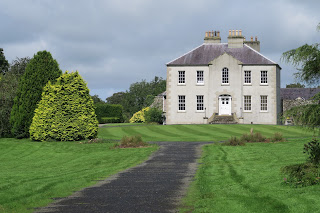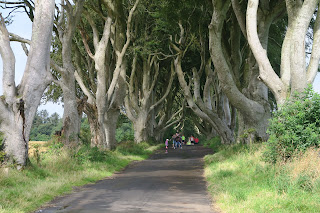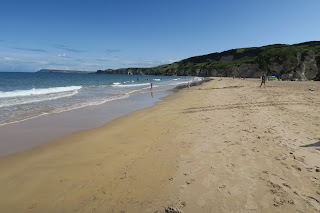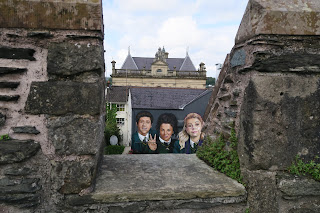According to local legend, the hedges are visited by a ghost called the Grey Lady who travels the road and flits across it from tree to tree. She is claimed to be either the spirit of James Stuart’s daughter or one of the house maids who died mysteriously in the house.
A tree preservation order was placed on the trees in 2004 - of the 150 trees originally planted by the Stuart family, about 85-90 remain today. The trees are in various states of health and are at risk in bad weather - but hopefully recent conservation efforts will help preserve the very unique natural phenomenon for as long as possible.
On the property of Gracehill House there are lots of little enchanted pathways
Gracehill House
Game of Thrones fans will recognize Door 7 (season 2, episode 1: The North Remembers) and an iron throne
I loved this!
It is quite a magical place
Back to the coast again to enjoy a little more of the stunning Northern Ireland scenery. One stop was at Portrush for a bit of time on the beach. I even had the chance to play ‘lifeguard’ while I was there. As you can see though, even in the height of summertime, the real lifeguards are in head to toe wetsuits for warmth!!
Dunluce Castle again - this time from the west
Good thing there were very few swimmers when I was on duty
The Royal Portrush Golf Club is the only golf club outside of Great Britain to host The Open Championship which it did in 1951...and again just a few days before I was there (in 2019).
From here it was on to Derry~Londonderry. Again, being the history-geek that I am I wanted to see a little bit of a city so steeped with history. It is a city with two names. Nationalists always use Derry, and the ‘London’ part of the name is often defaced on road signs (even today). Staunch Unionists insist on Londonderry, which is still the city’s (and county’s) official name. All the same, most people, regardless of political persuasion, call it Derry in everyday speech.
There’s lots of history to absorb here, from the Siege of Derry in 1688-89, to the Battle of the Bogside and Bloody Sunday during the Troubles, and I would love the chance to go back again and see more of this city.
“Londonderry West Bank Loyalists still under siege - No Surrender”
Built between 1628 and 1633, St. Columb’s Cathedral was the first post-Reformation church to be erected in Britain and Ireland, and is Derry’s oldest surviving building
The Guildhall, originally built in 1890. Its clock tower is modelled on London’s Big Ben. From 2000-2005 it was the seat of the Bloody Sunday Inquiry.
Shortly after the lifting of the siege of Derry in 1689, a new Presbyterian meeting house was built. The current First Derry Presbyterian church was opened in 1780 (on the same site as the earlier church of 1690)
The Apprentice Boys’ Memorial Hall was opened in 1877
The Chapel of St. Augustine (Church of Ireland) was built in 1872
For today though, I took a walk along Derry’s City Walls. Derry’s walled city is Ireland’s earliest example of town planning. Completed in 1619, Derry’s city walls are 8m high and 9m thick, and are the only city walls in Ireland to survive almost intact. Derry’s nickname, the Maiden City, derives from the fact that the walls have never been breached by an invader.
Butcher’s Gate
Magazine Gate
Shipquay Gate
I was on the wall for a Tartan Walk
Double Bastion, home to Roaring Meg, the most famous of the cannons used during the Siege of Derry
Back on the road again, crossing leaving Northern Ireland into County Donegal, with Dunfanaghy being tonight’s destination. Back to the coast again... and I thought the restaurant’s special of “whiskey and a pint” was a fabulous way to end a great day!























































Thanks for sharing this wonderful post with us. These are all such great photos. I am just amazed with all the wonderful landscapes. Have a great rest of your day and I hope you had a fantastic time.
ReplyDeleteGreg Prosmushkin